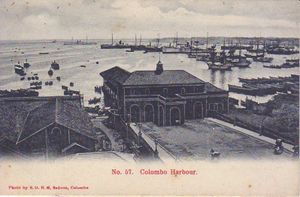Colombo Port Railways, Ceylon
Colombo Port Railways, Ceylon

An artificial harbour for Ceylon was first proposed in 1866 by the 4th Earl of Carnarvon, the Secretary of State for the Colonies when he suggested that a natural harbour at Galle be improved. In 1870 a proposal was put forward to build harbour at Colombo and construction commenced that year [1].
The Colombo Port was first laid out in 1875 with the building of the 'First Breakwater' (see below). The Port was then under the control of the Colombo Harbour Works. Two additional breakwaters were added in 1898 and 1912 to make the Port a closed harbour. Eighteen coaling jetties were completed in 1912. The 'Columbia Port Commissioners' was established in 1913 to operate the Port. Petroleum storage was added in 1922. By 1954 seventeen berths, together with associated transit sheds and warehouses, had been opened.
Railways
First Breakwater Construction, 1870-1885 [1]
- 'Mahara Quarry Branch' was the source of stone 11 miles(18km) from Colombo. A 1 miles, 34 chains (1.4mile/2.3km) of broad gauge(BG) track was laid from the quarry to a junction on the Ceylon Government Railway(CGR) mainline 9 miles(14km) from Colombo.
- 'Breakwater Construction Branch' was laid from the CGR Colombo Station and was 1 mile,62 chains (1.8mile/2.9km) long of BG track, it skirted Norris Road and terminated at Galle Buck. The site at Galle Buck was levelled and a concrete block yard constructed.
Second and Third Breakwater Construction
- 'Quarry Railway'. It is known that a light railway, presumably of broad gauge(BG), was used to convey material from the quarries to the construction sites of both the 'Second Breakwater', completed in 1898; and the 'Third Breakwater' , completed in 1912[2]..
Internal Port Railways
The Port of Colombo was connected to the broad gauge(BG) Ceylon Government Railway(CGR) mainline. The railway network was introduced by the British colonial government in 1864. The main reason for building a railway system in Ceylon was to transport tea and coffee from the hill country to Colombo. Initially the service began with the mailine of 54 kilometres connecting Colombo and Ambepussa [3].
The Port was served by an internal system of broad gauge(BG) lines.
References
- ↑ 1.0 1.1 “Industrial Railways and Locomotives of India and South Asia” compiled by Simon Darvill. Published by ‘The Industrial Railway Society’ 2013. ISBN 978 1 901556 82-7. Available at http://irsshop.co.uk/India. Reference: Entry WP02 page ....
- ↑ “Industrial Railways and Locomotives of India and South Asia” compiled by Simon Darvill. Published by ‘The Industrial Railway Society’ 2013. ISBN 978 1 901556 82-7. Available at http://irsshop.co.uk/India. Reference: Entry WP06 page ....
- ↑ Wikipedia "Sri Lanka Railways"; Retrieved 13 Dec 2017